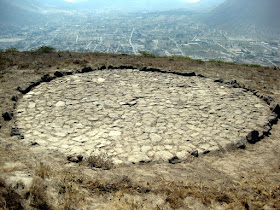Pages
▼
Sunday, July 22, 2012
Julius Wellhausen: Prolegomena to the History of Israel
The work which forms the greater part of the present volume first appeared in 1878 under the title "History of Israel. By J. Wellhausen. In two volumes. Volume I." The book produced a great impression throughout Europe, and its main thesis, that "the Mosaic history is not the starting−point for the history of ancient Israel, but for the history of Judaism," was felt to be so powerfully maintained that many of the leading Hebrew teachers of Germany who had till then stood aloof from the so−called "Grafian hypothesis" the doctrine, that is, that the Levitical Law and connected parts of the Pentateuch were not written till after the fall of the kingdom of Judah, and that the Pentateuch in its present compass was not publicly accepted as authoritative till the reformation of Ezra declared themselves convinced by Wellhausen's arguments.
Catequilla
Catequilla (also Kati-Killa) is an archaeological site in the Pomasqui Valley of Ecuador. Located in the Parish of San Antonio, near Quito, it has an elevation of 2,638 metres (8,655 ft). Attributed to the Pre-Columbian era Quitu-Cara culture, it was presumably used as an astronomical observatory even before the arrival of the Incas.
Catequilla is translated from Quechua to mean "follower of the moon".[1] Its construction, circa 800 AD, is attributed to the Quitu-Cara culture.[2] The site contains of a semicircular wall, 107 metres (351 ft) in length with a diameter of 68 metres (223 ft), although no clear architectural features accurately show the exact positions of its ends.
Catequilla is translated from Quechua to mean "follower of the moon".[1] Its construction, circa 800 AD, is attributed to the Quitu-Cara culture.[2] The site contains of a semicircular wall, 107 metres (351 ft) in length with a diameter of 68 metres (223 ft), although no clear architectural features accurately show the exact positions of its ends.
Exploring Italy’s lost city: Pompei
As semi-well traveled history buff, I'm always a little skeptical about visiting ancient sites of great significance for fear of disappointment. To me, Pompeii was one of those places. Could a site like this live up to the tales we were taught in grade school about how an ancient people were frozen in time after a deadly volcano descended upon them?
After traveling throughout southern Italy I had heard mixed reviews about the famous city buried under volcanic ash. While some locals said the ruins were a must-see, others thought they were over rated.
After traveling throughout southern Italy I had heard mixed reviews about the famous city buried under volcanic ash. While some locals said the ruins were a must-see, others thought they were over rated.


